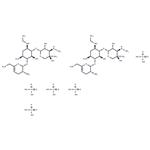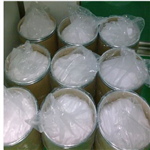Description
Netilmicin Sulfate is the sulfate salt form of netilimicin, a member of the aminoglycoside family of antibiotics. Netilmicin is derived from sisomicin, a naturally occurring aminoglycoside antibiotic produced by the fermentation of Micromonospora inyoensis. It is an active aminoglycoside antibiotic against most Gram-negative and some Gram-positive bacteria, including certain strains resistant to gentamicin.
Uses
Netilmicin sulfate is used as a broad spectrum antibiotic active against most Gram-negative and some Gram-positive bacteria. It is a semisynthetic 1-N-ethyl derivative of sisomycin, an aminoglycoside antibiotic with action similar to gentamicin, but has less ear and kidney toxicity. It is used to treat gram-negative bacterial infections, gonorrhea, skin infections, and other infectious diseases. Since netilmicin sulfate cannot be absorbed from the gut, it can only be administered by injection.
Application
Netilmicin was synthesized by ScheringPlough Co. in 1976. The ethyl moiety was introduced at the 1-amino group of sisomicin. Its design was based on an understanding of the biochemical mechanisms of bacterial resistance to the gentamicin – sisomicin antibiotic group. The modification at the 1-amino group is known to prevent adenylation at the 2- hydroxyl group and acetylation at the 3-amino group, and to deter acetylation at the 6 -amino residue. Netilmicin shows almost the same activity against a variety of gram-positive and gram-negative bacteria as sisomicin and strong activity against gentamicin – sisomicin-resistant bacteria. It is now under study for evaluation of its clinical efficacy and safety.
Clinical Use
Netilmicin sulfate, 1-N-ethylsisomicin (Netromycin), is asemisynthetic derivative prepared by reductive ethylation138of sisomicin, an aminoglycoside antibiotic obtained fromMicromonospora inyoensis. Structurally, sisomicin andnetilmicin resemble gentamicin Cla, a component of the gentamicincomplex.
Against most strains of Enterobacteriaceae, P. aeruginosa,and S. aureus, sisomicin and netilmicin are comparableto gentamicin in potency. Netilmicin is active, however,against many gentamicin-resistant strains, in particularamong E. coli, Enterobacter, Klebsiella, and Citrobacterspp. A few strains of gentamicin-resistant P. aeruginosa, S.marcescens, and indole-positive Proteus spp. are also sensitiveto netilmicin. Very few gentamicin-resistant bacterialstrains are sensitive to sisomicin, however. The potency ofnetilmicin against certain gentamicin-resistant bacteria is attributedto its resistance to inactivation by bacterial enzymesthat adenylylate or phosphorylate gentamicin and sisomicin.Evidently, the introduction of a 1-ethyl group in sisomicinmarkedly decreases the affinity of these enzymes forthe molecule in a manner similar to that observed in the1-N-ε-amino-α-hydroxybutyryl amide of kanamycin A(amikacin). Netilmicin, however, is inactivated by most of the bacterial enzymes that acetylate aminoglycosides,whereas amikacin is resistant to most of these enzymes.
The pharmacokinetic and toxicological properties ofnetilmicin and gentamicin appear to be similar clinically,though animal studies have indicated greater nephrotoxicityfor gentamicin.




